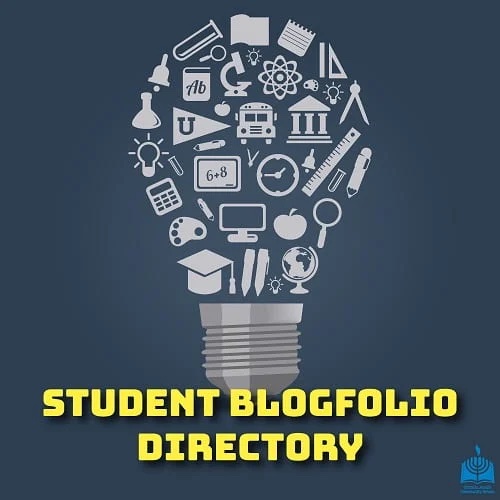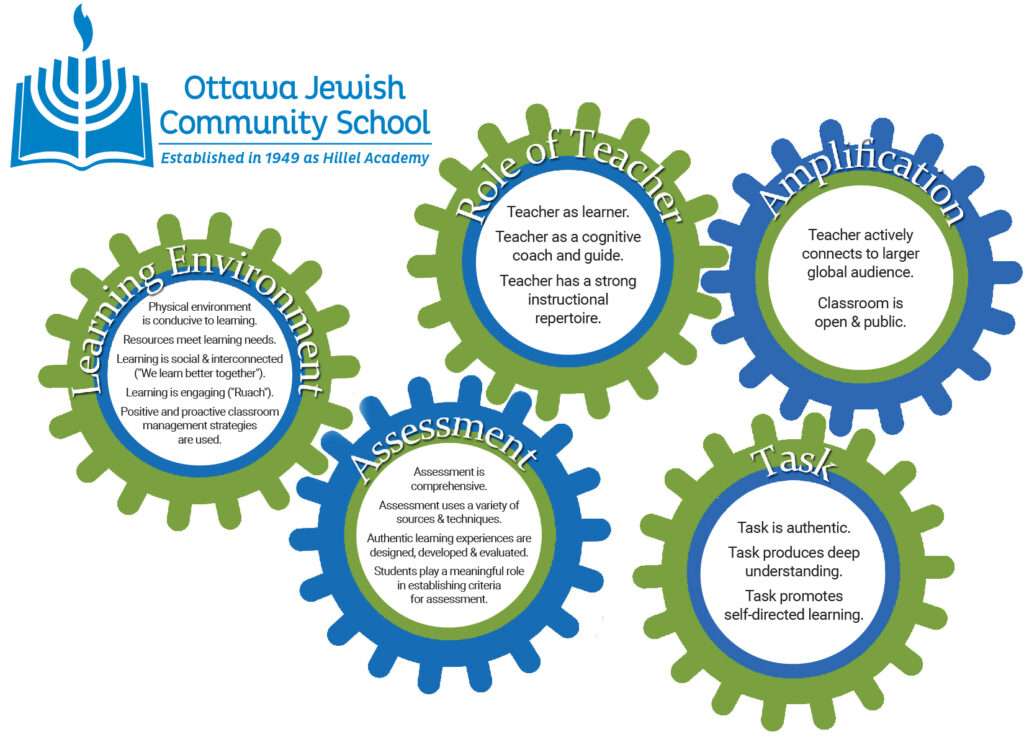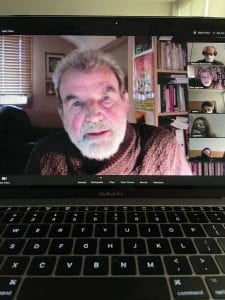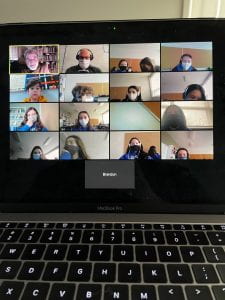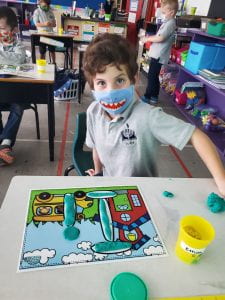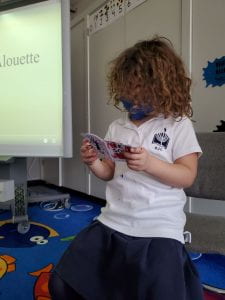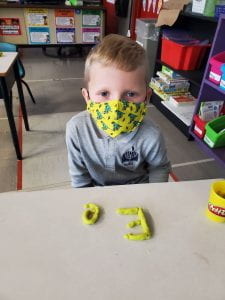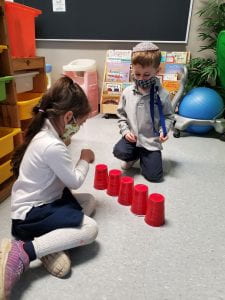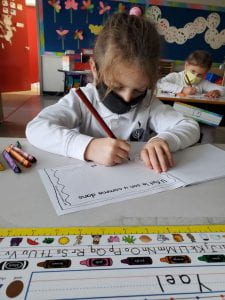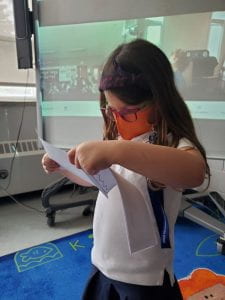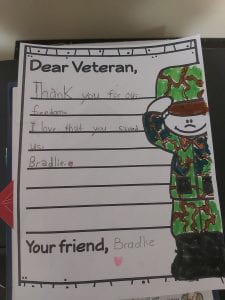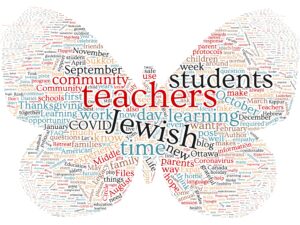I can think of no better use of my blog on a snowy April day during a lockdown pivot of distanced learning than shining a light on the newest and fastest growing space on our OJCS Blogosphere, our Student Blogfolios.
For those who don’t like to click through, I’ll remind you that a “blogfolio” is a term of art that (I believe) my former colleague Andrea Hernandez created, and in her words:
Portfolios give students a chance to develop metacognition, set goals and internalize what “good work” looks like. Blogs offer a platform for creativity, communication, connection and the practice of digital citizenship. “Blog-folios”are the best of both worlds- using a blogging platform to develop writing skills, provide opportunities to connect with an authentic audience and increase reflective practices. Instead of using the entire site as a portfolio, students will use the category “portfolio” to designate those selections that represent high-quality work and reflection.
We added “student blogfolios” to our blogfosphere a couple of years ago with a prototype in Grade 5 and now each current student in our school in Grades 3-7 has his or her own blogfolio.
I try to spend a couple of hours each week reading student blogfolios and what I enjoy seeing the most is the range of creativity and personalization that expresses itself through their aesthetic design, the features they choose to include (and leave out), and the voluntary writing.
This is what we mean when we talk about “owning our own learning” and having a “floor, but not a ceiling” for each student. It is also a great example of finding ways to give our students the ability to create meaningful and authentic work. But, it isn’t just about motivation – that we can imagine more easily. When you look more closely, however, it is really about students doing their best work and reflecting about it. Look at how much time they spend editing. Look at how they share peer feedback, revise, collaborate, publish and reflect.
This year, with the building largely sealed off due to COVID protocols, our classroom blogs and student blogfolios become even more important virtual windows into the innovative and exciting work happening at OJCS. Recognizing that it still may be a new routine for families and that most families surely don’t have the bandwidth to visit all the blogs, it is my pleasure to serve as your occasional tour guide of The OJCS Blogosphere. I do this a few times a year to inspire OJCS families to invest a little time, to inspire other schools and thought-leaders who may visit my blog from time to time, and to forge connections between our work and other fellow-travelers because we really do “learn better together” [North Star Alert!]
This week I will focus for the first time on student blogfolios. [Please note that due to privacy controls that some OJCS students opt for avatars instead of utilizing their first names / last initials which is our standard setting. That may explain some of the creative titles below.]
From Audrey’s Blog (Grade 6 / click here for the full blog)
The Best Moment of My Life – Posted March 17
My class is learning all about sensory writing.
Sensory writing is really important to incorporate into your stories, paragraphs, etc. because it helps the reader imagine what you are trying to explain and it helps the reader picture the setting.
If I were to redo this assignment, I would try to make the writing longer and extend the paragraphs.
Here is my picture and my sensory writing

I had no idea where my parents were taking me that day. The suspense was overtaking me and I felt worried for what was to come. Was I walking into a trap or were they leading me to the most wonderful place I will ever go to? My parents refused to tell me where we were going which only fed my anticipation. The car slowed to a stop in a vacant parking lot, all I saw were willow trees around us. As I slowly stepped out of the car and my parents told me to walk through a path nearby. When I reached the other side of the trees I was flabbergasted with the sight.
I found myself standing on the beach, gazing at the outstanding sunset with a mix of yellow, orange and purple. The sun was low in the sky as if it was playing a game of hide and seek. The sun reflected on the waves that were crashing against the shore line, then very slowly creeping its way back to the water, creating a soothing noise. The air smelled like smoke from a hut in the distance. I could just imagine a family roasting marshmallows over a bonfire fire as they told scary stories. The sand was very soft on my feet as if I were standing on a pill of feathers. The sand was molding my feet making it a reasonable thing to decide to stand rather than sit. The taste of sea salt on my lips created the illusion that I was swimming in the water. As i sat down on the sand i could feel the warmth overfilling me. I could tell already that this was hands down, the best moment of my life!
I hope you enjoyed this story
Have you ever been to an outstanding place?
If so where? What happened while you were there? What were your feelings about the sight?

From TE’s Blog (Grade 4 – click here for the full blog)
Innovation Day – Pulley Project – Posted March 18
[Jon’s Note: TE’s teacher nominated this blog post in part because she is new to OJCS this year and is just learning English. Part of the magic of blogfolios is how well it allows you to chart progress over time!]
ELEVATOR
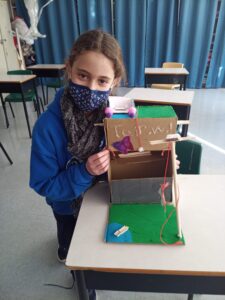
What did I need for the elevator I built: wire, 2 long pieces of cardboard, a box, 2 short pieces of cardboard, and a stick
How I connected all the parts: I took the hot glue and the 2 long parts and the 2 short parts I put 1 of the long parts
And on both sides I glued the short parts
And over the short parts I glued the last long part
- How I started the structure of the elevator: I took the box and made 2 holes up the holes and inserted the stick into the holes.
- How I build the evaluator pulley: I take the string and fold it. At the end of the fold, I glued it to the dowl (wooden stick). at the other end, I glued the elevator box
- How I built the flag pole: take a large wooden pole and glued it to the base. I take more wooden sticks and glue them to the top. I take two small pieces of cardboard and make a square shape to make a pulley. Between the small cardboard, I put the rope through and on one end draw a ‘T’ and two swords on the square flag. I glue the flag to the rope.

From Maytal’s Blog (Grade 7 – click here for the full blog)
Hebrew/Photo – Posted April 20
[Jon’s Note: I never choose my own children to highlight; this came as a recommendation from her Hebrew Teacher. However, as student blogfolios were a big part of my last headship, Maytal’s blogfolio shows what it looks like when you start in Kindergarten. Any OJCS parent who wants to see what it will ultimately look like should take a peek.]
בכיתה שלנו לעברית מורה רותי נתנה לנו 3 תמונות לבחירה. היינו צריכים לבחור אחת ולכתוב עליה. אני בחרתי בתמונה הזאת. אני מתארת את מה שאני חושבת על התמונה.
In our Hebrew class Morah Ruthie gave us three options to write about. I chose this photo down below. I described what was happening in the photo.

בתמונה יש 5 חיילים ויש חייל אחד עם מדים עם דם. החייל הזה נהרג והחיילים מאחור זה הוא עצמו שמבקש לא לבכות לבכות עליו. הוא גם מבקש סליחה על מה שהוא עשה והוא מנסה לדבר אל החיילים שלא נהרגו.
In the photo there are five soldiers and there is one soldier who is a different colour with blood. The soldier was killed and in the background you can see the exact soldier asking not to cry for him. He is asking for forgiveness for things he has done, and trying to communicate to soldiers who are still alive.

From Hermione’s Blog (Grade 3 – click here for the full blog)
French Blog Post – Posted February 5
Quel est le nom du dernier film que tu as vu?
Lightning Mcqueen
Combien de lettres contient ton nom de famille ?
J’ai 6 lettres dans mon nom de famille.
Qu’as-tu mangé pour déjeuner ce matin ?
Des céréales avec du lait
As-tu des animaux à ta maison ? Si oui, lesquels ?
J’ai un chien.
Quel est ton sport préféré ?
Natation
Quelle est ta nourriture préférée ?
Pain dore
Quelle est ta couleur préférée ?
bleu
Nomme ton livre préféré.
Harry Potter
Quel mois est ton anniversaire ?
decembre
Quel est ton animal préféré ?
Lou arctic
Quel est ton sujet préféré à l’école ?
Les sciences

Do you want more? Here is a curated playlist from our Teaching & Learning Coordinator Melissa Thompson:
Grade 3
- Science: https://
blueenergyojcs.edublogs.org/ 2021/03/25/innovation-day/ - Jewish Studies: https://davidjojcs.
edublogs.org/2021/02/11/my- timeline/ - French: https://hermioneojcs.
edublogs.org/2021/02/05/ french-blog-post/
- LA: https://map13ojcs.
edublogs.org/2021/02/05/grade- 4-magazine-sports-section/ - Independent: https://inamojcs.
edublogs.org/2021/04/09/ negrochia-my-ideal-country-by- ina-m/ - French: https://lilamojcs.
edublogs.org/2021/02/24/ bianca-andreescu/ - Social Studies: https://meadowojcs.
edublogs.org/2020/11/26/the- mayans-science-and-technology/
- Science: https://
harden3ptojcs.edublogs.org/ 2021/03/23/innovation-day/ - Science: https://mialojcs.edublogs.
org/2021/01/24/scientists-in- the-school/ - French Extended: https://callieojcs.
edublogs.org/2021/03/04/passe- composse-family-vacation/ - French Core: https://georgiajojcs.
edublogs.org/2021/04/10/ma- ville/ - Math: https://lazerojcs.
edublogs.org/2020/12/11/2- digit-by-2-digit/ - Language Arts: https://adamlojcs.
edublogs.org/2021/01/21/masks- paragraph-minecraft-paragraph- reflection-by-adaml/ - Art: https://superstar31ojcs.
edublogs.org/2021/01/14/my- art-drawing/ - Jewish Studies: https://
superstar31ojcs.edublogs.org/ 2020/10/13/%d7%94%d7%a8%d7%90% d7%a9-%d7%94%d7%a9%d7%a0%d7% 94-%d7%a9%d7%9c%d7%99/
- Hebrew: https://joeyshojcs.
edublogs.org/2021/04/21/yom- haatzmaut-%d7%99%d7%95%d7%9d-% d7%94%d7%a2%d7%a6%d7%9e%d7%90% d7%95%d7%aa/ - Science: https://audreyojcs.
edublogs.org/2021/01/18/space- shuttles/ - Social Studies (French) https://shyleemojcs.
edublogs.org/2020/12/09/ equity-and-equality/ - Elective: Passion Project: https://miggyojcs.
edublogs.org/2021/03/06/my- first-hockey-tutorial/
- Jewish Studies: https://audreybojcs.
edublogs.org/2020/11/23/ jewish-values-project/ - French: https://halelwojcs.
edublogs.org/2021/04/20/52/ (This is an Israeli student FYI!!!) - Language Arts: https://griffinojcs.
edublogs.org/2021/01/08/my- covidcation/ - Science: https://ezramrojcs.
edublogs.org/2020/11/25/ biosphere/

English, French and Hebrew; Language Arts, Science, Math, Social Studies, Jewish Studies and so much more…our students are doing some pretty fantastic things, eh?
I will continue to encourage you to not only check out all the blogs on The OJCS Blogosphere, but I strongly encourage you to offer a quality comment of your own – especially to our students. Getting feedback and commentary from the universe is highly motivating and will help this snowball (no pun or passive-aggressive take on what is happening outside my window!) grow as it hurtles down the hill of innovative learning.
Where will our next tour take us? Stay tuned!

